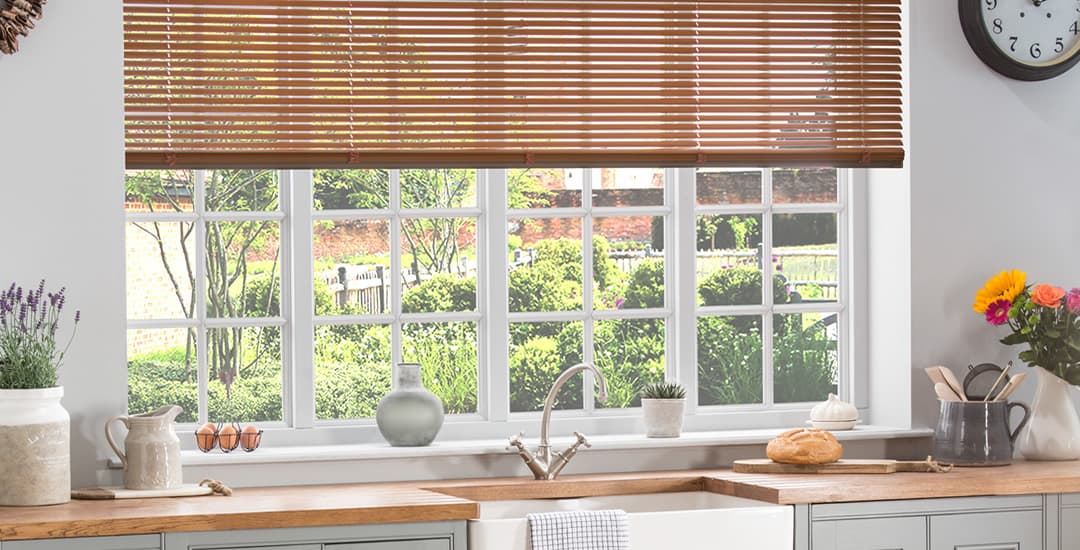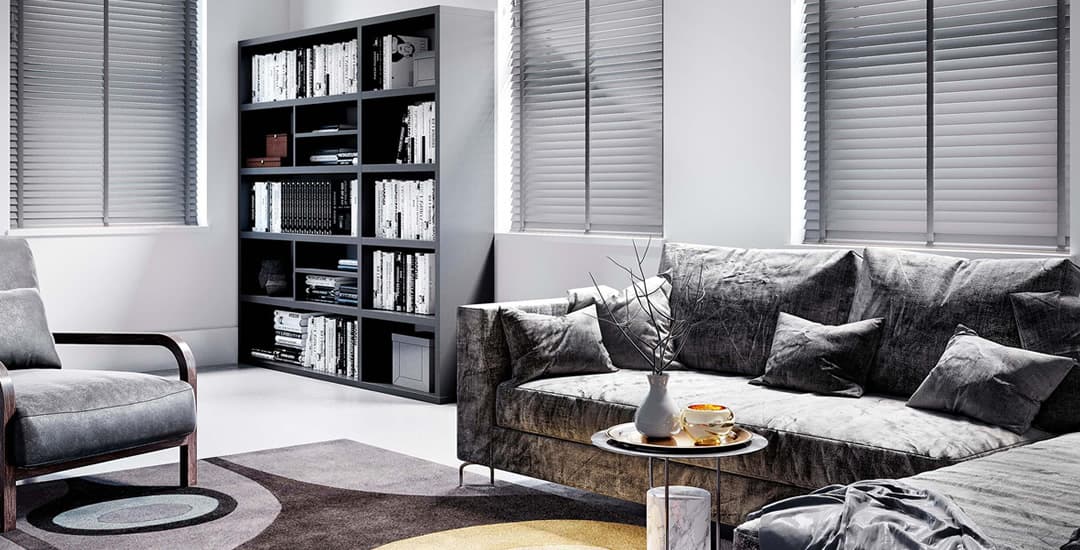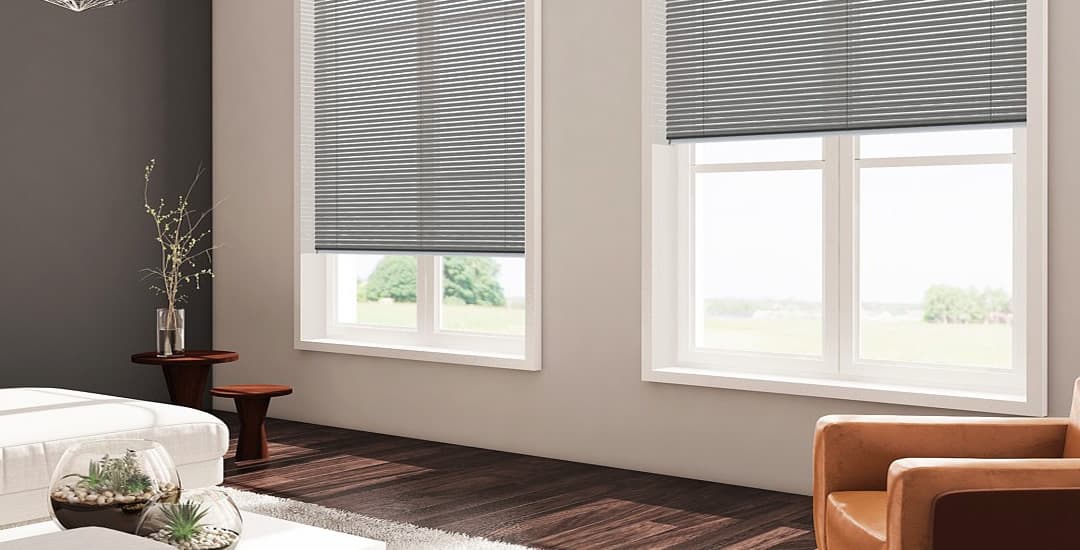
Venetian blinds come in various different materials and of course, levels of quality, but the short answer to “do Venetians cost more than other types of blinds” is that aluminium Venetians fall towards bottom of the price scale, faux-wood Venetians around the middle, and real wood Venetians towards the top.
If you want a more detailed explanation of this along with some added pointers on whether or not Venetian blinds towards the higher end of the price scale are worth the money, read on while I do my thing.
What are Venetian blinds and how do they work?
The term “Venetian blinds” refers to window blinds made of rows of horizontal slats, which can be tilted to the angle of your choice to filter light, provide privacy, and allow you to enjoy the view without the view necessarily enjoying the sight of you in your WFH gear in turn.
Venetian blinds can be made from a number of different materials, most commonly being aluminium, real wood, and faux wood respectively. You can also get plastic Venetian blinds, albeit not from us, because urgh.
When you hear the term “Venetian blind” used without a qualifier about the material in question, this almost universally refers to aluminium Venetian blinds specifically, although it’s worth checking just to make sure.
On the flip side, faux-wood and real wood Venetian blinds are often just called “wooden blinds” or “faux wood blinds” respectively, without any mention of the word Venetian; but wood and faux-wood blinds only come in Venetian style, and so this is something you can take as script.
Do Venetians cost more than other types of blinds?

Price-wise then, do Venetians cost more than other types of blinds? Not necessarily; some Venetian blinds fall towards the higher end of the blinds price spectrum, while others land right at the bottom.
As mentioned above, Venetian blinds come in different materials, and what the blind in question is made of will dictate to a reasonable degree how costly that blind is like for like compared to other types of blinds.
Ready made plastic Venetian blinds, which we don’t tend to see or talk about much because essentially they’re kind of nasty, are quite possibly the cheapest blinds of all, and boy do they look it; hence my less-than-subtle distain for Venetians made of this uncommon and equally unpopular option.
In terms of Venetian blinds types widely offered for sale and that don’t look ick, aluminium Venetian blinds are the most economical type of Venetian blind and you will tend to find that these will cost you less like for like than most other types of blinds on the market.
Real wood Venetian blinds on the other hand are a lot higher up the pecking order in terms of spendiness; and in some cases, only Roman blinds (these are pretty much the benchmark of luxury/costliness to which all other blinds are compared) cost more than real wood Venetians.
Faux-wood Venetian blinds fall around the middle of the pack; and this is why I don’t have a one-word answer to your question of “do Venetians cost more than other types of blinds;” because material dependent, there will be a Venetian near the top of any price ranking, one around the middle, and one close to or at the bottom.
Are Venetian blinds cheaper than roller blinds?
This depends on the Venetian blind in question. Those not-very-popular ready made plastic Venetian blinds that might be more or less impossible to find offered for sale at all will tend to be cheaper than roller blinds, while aluminium Venetian blinds tend to cost a little more than an equivalent roller blind.
However, sometimes aluminium Venetians and rollers will come in at almost exactly the same price. Both faux-wood and real wood Venetian blinds will almost certainly cost you more than an equivalent roller blind though.
As a general rule, roller blinds are like-for-like the cheapest type of window blind to buy. If you start adding in special features such as a blackout lining, designer fabrics, and waterproof options, the price rises a bit, but rollers overall are not considered to be expensive compared to other types of blinds.
Aluminium Venetian blinds tend to be just a shade more expensive than rollers, and I do mean a shade; if you check out this blog post where I made a table showing the average price of different types of window blinds in the UK as of late 2021, an average-sized (120x120cm) roller blind from us costs £33; a blackout version £36; and an aluminium Venetian blind of the same dimensions, £37.
As you can see then there is very little in it when it comes to the cost of an average roller blind compared to the cost of an average aluminium Venetian blind, and potentially some level of crossover too.
So if you’ve narrowed your options down to a certain aluminium Venetian and a specific patterned roller blind and said pattern was one of our more expensive fabrics, the Venetian might actually cost you less.
Are Venetian blinds worth it?

If you’ve got your heart set on a more costly Venetian blind because you want the sort of light and privacy-filtering functionality that only Venetians can provide, or because the style is exactly what you want for your room, you might well be trying hard to talk yourself into, or maybe out of, the decision.
So, are Venetian blinds worth it? Well, in terms of their longevity (tending to be well north of a decade and potentially up to two) Venetian blinds are a good investment and not one that’s going to come back and bite you in the butt a couple of years later because bits have started to fall off them.
As is the case for anything, this does rely on the blind being used in the appropriate environment (not using a wooden Venetian blind in a damp or humid environment like a kitchen or bathroom, for instance) and not subjecting them to unduly rough handling.
Style-wise, Venetian blinds also age well; unlike some fabrics and patterns that you might pick for a roller blind or Roman blind that’s sizzling hot today, your Venetian of pretty much any colour and material is still going to suit your room and not look dated a couple of years down the line.
All of this really only holds true though if you’re looking for window blinds that will be in it for the long haul. If you redecorate or get bored of your room décor every couple of years and replacing the blinds is a part of this, you might find real wood and faux-wood Venetians to be a poor investment if you’re planning to start again with something else in short order.
Aluminium Venetians may still be on the cards though, these being fairly economical to buy.
However, if you tend to redecorate no sooner than every 4-5 years or potentially a lot longer, Venetian blinds will work out very economical, regardless of the type and their initial purchase price.
Also, while all blinds insulate the window to some extent, real wood and faux-wood Venetian blinds are super-good at this. These two choices can actually help to noticeably lower your heating bills, particularly if your windows are large or poorly insulated and so, a major cause of heat loss; to the point that if you keep them longer term, they might realistically pay for themselves…
…Although given the speed at which energy costs in the UK are rising right now, I might need to circle back to this blog post at the end of the year and correct this claim to “may pay for themselves within 18 months…”




